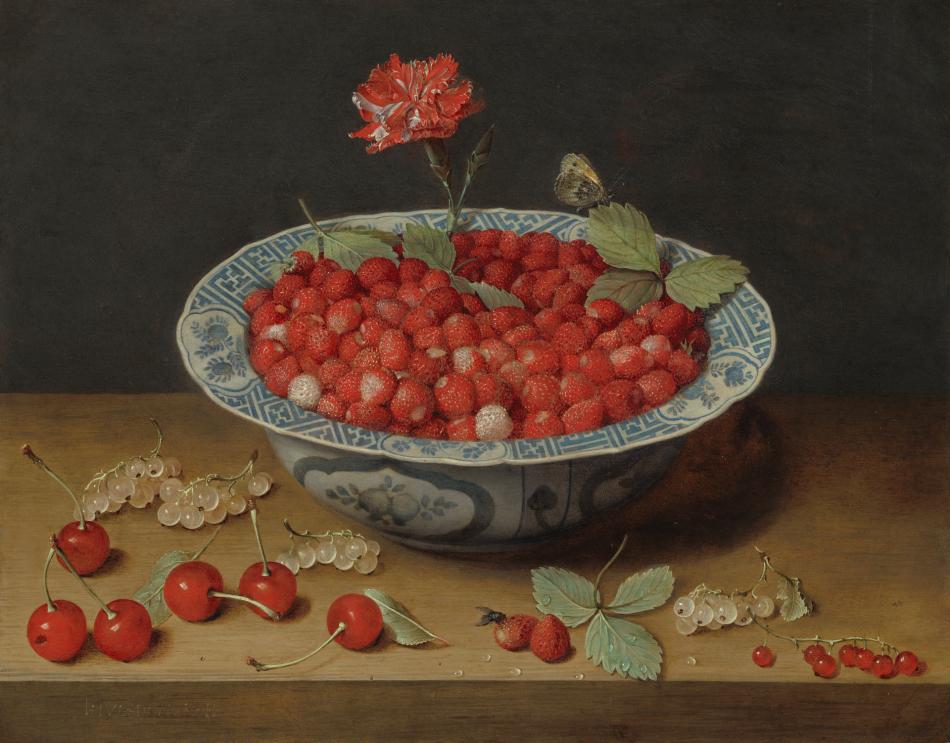Estuary at Day's End
c. 1640/1645
Simon de Vlieger
Painter, Dutch, 1600/1601 - 1653
By the mid-seventeenth century the Dutch were the greatest sea power in the world. Their ships dominated the oceans, ensuring not only the military security of the Republic but also its prosperity. Indeed, the combination of regional and global trade brought everything from exotic spices to bulk staples, such as grain and salt, to the Dutch ports.
Simon de Vlieger's most innovative paintings, including this Estuary at Day’s End, capture the flavor of daily life along the Dutch coast. In this restrained and sensitive composition, two workers apply tar to the hull of a ship resting on a sandbar at low tide. Black smoke from the fire that heats the tar rises up toward the towering clouds, while dramatic rays of light break through the thinner layer of clouds on the left. In the background, smoke erupts from the cannon of a large Dutch ship firing a salute. The scene is simple, but the effects of light and atmosphere give the painting a tremendous sense of drama, and these qualities can be fully appreciated thanks to the work's remarkable state of preservation.
De Vlieger was one of the most important and influential Dutch marine painters. A versatile artist, he was equally comfortable painting dramatic storms or stately naval parades, all of which he enlivened with small figures carefully situated within the pictorial context. He clearly knew the sea and the ships that sailed it: he accurately recorded the distinguishing features of the various types of vessels—from large navy ships to small fishing and transport boats—and set them convincingly in the water. But De Vlieger's sensitivity to the atmospheric effects of water and sky along the North Sea truly separates him from most other marine painters. He was unmatched in capturing the subtle ranges of grays and gray-blues found along coastal waters.

West Building Main Floor, Gallery 50-B
Artwork overview
-
Medium
oil on panel
-
Credit Line
Patrons’ Permanent Fund and The Lee and Juliet Folger Fund in memory of Kathrine Dulin Folger
-
Dimensions
overall: 36.8 x 58.4 cm (14 1/2 x 23 in.)
framed: 50.2 x 72.4 x 6.7 cm (19 3/4 x 28 1/2 x 2 5/8 in.) -
Accession Number
1997.101.1
More About this Artwork

Video: Two-Minute Tour: Clouds, Ice, and Bounty
Join exhibition curator Betsy Wieseman on a two-minute tour of the 2021-2022 exhibition Clouds, Ice, and Bounty.
Artwork history & notes
Provenance
Edward Donner, Hurstbourne Park, Hampshire, England, by 1990; sold 1997 through (Gurr-Johns, London) to NGA.
Associated Names
Exhibition History
1990
Loan for display with permanent collection, National Gallery, London, 1990-1995.
1998
A Collector's Cabinet, National Gallery of Art, Washington, D.C., 1998, no. 64, fig. 25.
2000
The Glory of the Golden Age: Dutch Art of the 17th Century, Rijksmuseum, Amsterdam, 2000, exhibition catalogue in two volumes, no. 85 (of Painting, Sculpture and Decorative Art catalogue), repro., as Seascape in the Morning.
Art for the Nation: Collecting for a New Century, National Gallery of Art, Washington, D.C., 2000-2001, unnumbered catalogue, repro.
2018
Water, Wind, and Waves: Marine Paintings from the Dutch Golden Age, National Gallery of Art, Washington, D.C., 2018, unnumbered brochure, fig. 8.
2021
Clouds, Ice, and Bounty: The Lee and Juliet Folger Fund Collection of Seventeenth-Century Dutch and Flemish Paintings, National Gallery of Art, Washington, 2021, no. 1, repro.
Bibliography
1998
Wheelock, Arthur K., Jr. A Collector's Cabinet. Exh. cat. National Gallery of Art, Washington, 1998: 35, 68, no. 64, fig. 25.
2000
National Gallery of Art. Art for the Nation: Collecting for a New Century. Exh. cat. National Gallery of Art, Washington, 2000: 36-37, color repro.
Kiers, Judikje, and Fieke Tissink. The glory of the Golden Age: Dutch art of the 17th century. 2 vols. Edited by Jan Piet Filedt Kok and Bart Cornelis. Vol. 1: Painting, sculpture and decorative art. Exh. cat. Rijksmuseum, Amsterdam, 2000: 1:5, no. 85.
2004
Hand, John Oliver. National Gallery of Art: Master Paintings from the Collection. Washington and New York, 2004: 211, no. 167, color repro.
2007
Wheelock, Arthur K., Jr., and Michael Swicklik. "Behind the Veil: Restoration of a Dutch Marine Painting Offers a New Look at Seventeenth-Century Dutch Art and History." National Gallery of Art Bulletin no. 37 (Fall 2007): 4, fig. 4.
Inscriptions
lower right: S DE VLIEG[ER]
Markings
CM: unidentified red seal
Wikidata ID
Q20177169





